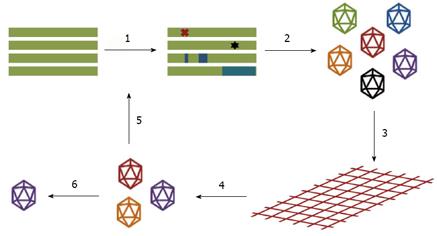Copyright
©2013 Baishideng Publishing Group Co.
World J Stem Cells. Oct 26, 2013; 5(4): 98-105
Published online Oct 26, 2013. doi: 10.4252/wjsc.v5.i4.98
Published online Oct 26, 2013. doi: 10.4252/wjsc.v5.i4.98
Figure 3 Schematic of steps in the directed evolution of adeno-associated virus.
The wild-type adeno-associated virus (AAV) cap genes are mutated to create large genetic libraries (1) and the mutant cap genes are packaged to generate libraries of AAV particles (2), with each AAV composed of a variant capsid surrounding a viral genome encoding that capsid. The resulting AAV libraries can be subjected to appropriate selective pressures (3) to isolate vectors with modified capsids that facilitate the AAV variants to efficiently surmount these pressures (4). Examples include isolation of AAV variants with the ability to evade neutralizing antibodies, altered receptor binding and cell tropism, and enhanced gene delivery. Successful AAV variants are amplified and recovered (6), or can be subjected to additional rounds of mutagenesis and selection (5). Adapted from Maheshri et al[33] and Bartel et al[35].
- Citation: Ramamoorthi K, Curtis D, Asuri P. Advances in homology directed genetic engineering of human pluripotent and adult stem cells. World J Stem Cells 2013; 5(4): 98-105
- URL: https://www.wjgnet.com/1948-0210/full/v5/i4/98.htm
- DOI: https://dx.doi.org/10.4252/wjsc.v5.i4.98









